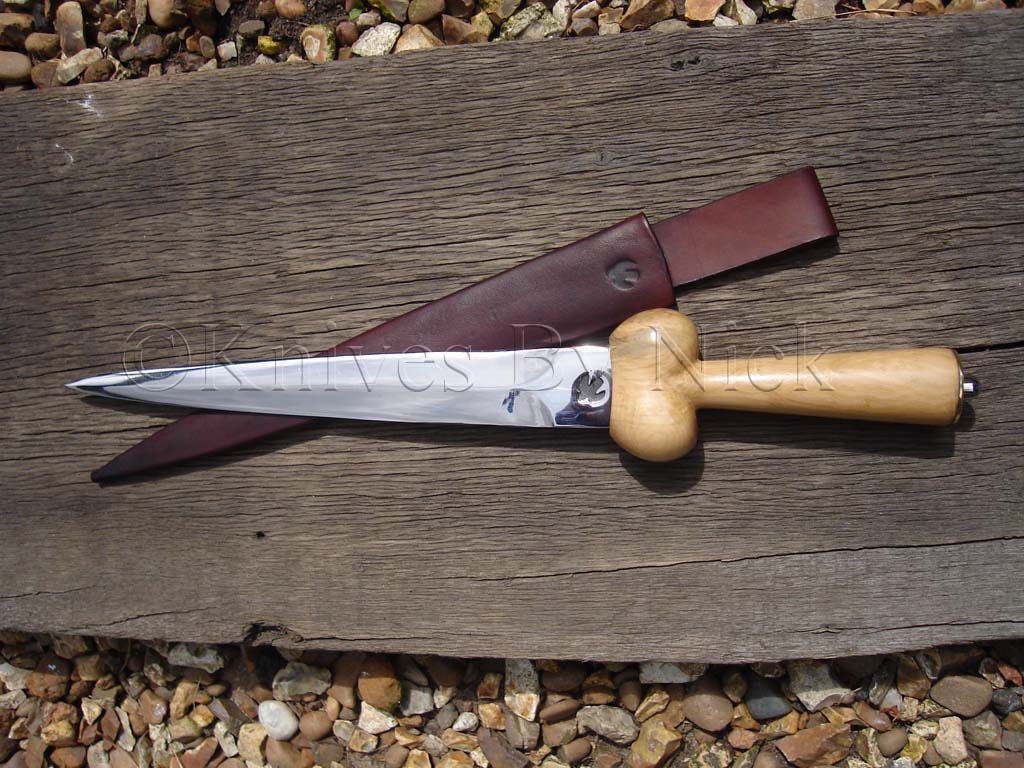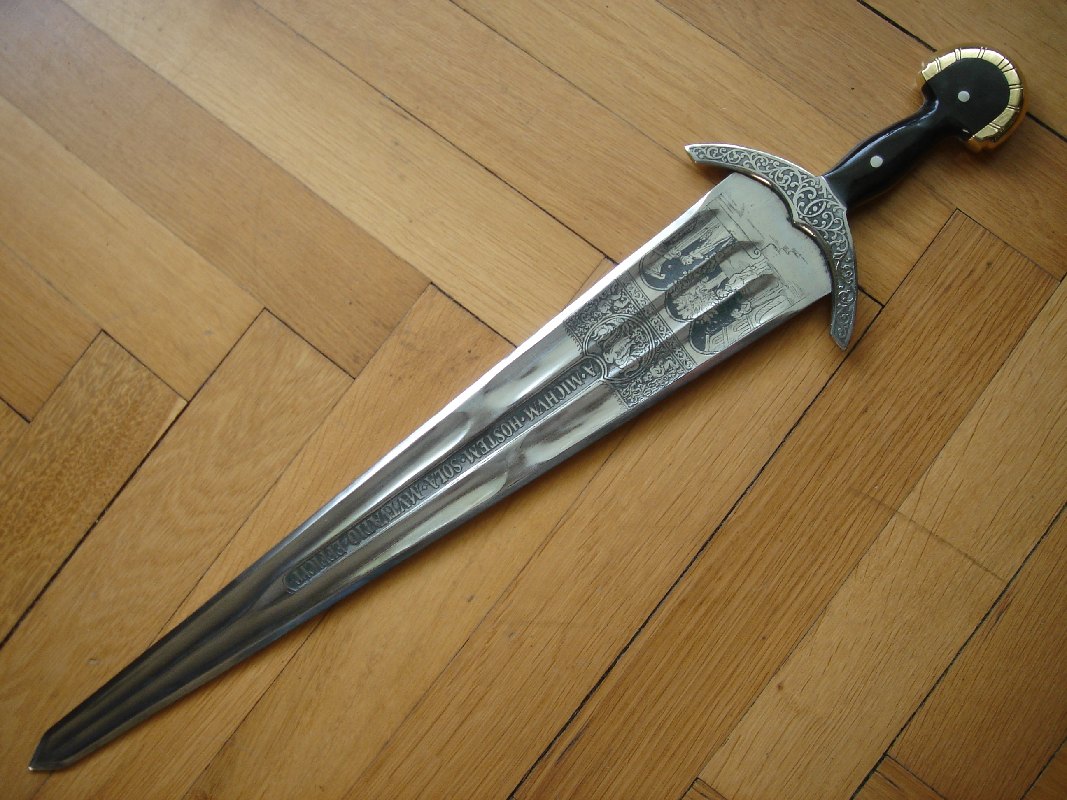|
|
|
|
|
|
|
|
|
|
|
|
|
|
|
|
|
|
The common dagger
is a wonderful weapon: it weighs a
pound; is 15" long; has a speed factor
of two; does 1-4 hit
points against small- and medium-sized
creatures, and 1-3
against larger threats; has reasonable
adjustments against
most armor classes; and can be flung to
a range of 30?
indoors and 30 yards outdoors. Rarely is
there a fighter,
thief, or magic-user who does not carry
a dagger or a
knife. Clerics
often carry one or the other as a general
tool. Daggers and knives can be found in
backpacks or
boots, on belts, strapped to ankles, forearms,
chests, and
thighs (and concealed up a character?s
nose, if the player
can talk the DM into it).
It seems strange, then, that while there
are six swords in the PH, <>
two more in the UA, <>
and three more in the OA, <>
there is only the dagger in the first book
and the knife in the second.
The parang (machete) in the third book
is logically treated as a sword, although it is usually defined as a knife.
<??>
All-purpose tool
First of all, a dagger is not an adequate
tool. It was designed specifically for
fighting,
and that is the only thing it does well.
It cannot efficiently split wood or shave
it
for kindling, scrape skins, or cut bait.
A
much better choice for this is the standard
knife. Modern hunters have used a
reduced bowie-pattern blade for much of
this century, and this is a style often
used
for many sorts of ?survival knives? available
today. A reduced bowie and a variety
of similar knives can be easily lumped
together under the heading knife, and
standard AD&D®
game statistics can be
used to define them.
There are many accessories placed on
modern all-purpose knives, but these
reflect this century and are inappropriate
for the AD&D
game setting. The only
exception that the DM might allow is a
saw blade on the back of a knife; sawbacked
knives date from the 18th century.
The only change that this feature makes
is
the addition of a small sum (perhaps 2
gp)
to the price; in addition, it allows the
knife
to be as effective as a small axe in clearing
brush or gathering wood.
Concealable
weapons
The main problem with the standard
dagger
is that it is a formidable weapon. It
is 15" long, 10" of which is blade. The
blade is 2½-3? broad at the haft,
and the
crossguard is easily 6? across. Such a
weapon is extremely difficult to hide,
especially in boots and sleeves, which
seem to be the two most commonly
attempted locations.

A kidney dagger has a substantially
reduced blade and a much more compact
hilt (especially the kidney-shaped
crossguard). The blade is very sharp and
is
intended to cut through clothes, not
armor. This kind of dagger was often
carried by ladies; it is a good choice
as a
spare knife for any serious adventurer.
<http://en.wikipedia.org/wiki/Bollock_dagger>

The cinquedea is an enormous dagger,
no longer than the most common variety
but almost twice as broad. The name
derives from the tradition that the blade
is
five fingers broad at the haft. This weapon
is recommended for magic-users.
It cannot
compete with the short sword or weapons
of that type for a berth in a fighter?s
arsenal,
but it can give a low-level magic-user
a
better chance to survive being cornered
in
a dark alley by a couple of thieves after
his
spells have run out. Although a magic-user
isn't supposed to fight, sometimes it's
unavoidable. A quarterstaff helps in these
cases, but it takes more space to use and
is
much slower. Also, a quarterstaff is a
hard
weapon to overlook, whereas the cinquedea
can be carried far less conspicuously.
The push knife is shaped like a capital
T.
The crosspiece is grasped so that the blade
extends between the second and third
fingers. The character then punches with
the hand holding the knife. Due to the
unusual position of the blade, blows with
the push knife can be struck with considerable
force.
There is a magical item detailed in
UA called the buckle
knife.
It is a small knife hidden in a belt buckle,
and treated as a knife for damage. Small
push knives have been hidden in this way;
the sheath lies horizontally along the
inside edge of the belt. Fortunately there
is
a provision allowing the knife to be drawn
without the belt coming undone.
Table 1: Knife Statistics
| Knife | Weight
gp |
Cost
gp |
Damage:
S-M |
Damage:
L |
Length | Space
Required |
Speed
Factor |
| Cinqueda | 20 | 6 | 1-6 | 1-4 | 15" | 1' | 6 |
| Kidney dagger | 5 | 3 | 1-3 | 1-2 | 7" | 1' | 2 |
| Push knife | 5 | 4 | 2-3 | 1-2 | 6" | - | 2 |
| Buckle knife | 3 | 8 | 1-3 | 1-2 | 2" | - | 1 |
| Throwing knife | 6 | 10 | 1-2 | 1 | 10" | 1' | 2 |
| Throwing knife (thrown) | 6 | 10 | 1-4 | 1-3 | 10" | 1' | z |
| Saw-backed knife* | 4 | - | - | - | - | - | - |
| Folding knife* | 2 | - | - | - | - | - | - |
* See "knife" in UA.
Table 2: Knife Firing Rates and Ranges Ranges
| Knife | Fire
rate |
S | M | L |
| Cinqueda | 1 | 1 | 2 | 3 |
| Kidney dagger | 2 | 1 | 2 | 3 |
| Throwing knife | 3 | 2 | 4 | 6 |
| Saw-backed knife | 2 | 1 | 2 | 3 |
Table 3: Adjustments vs. Armor Class
| Knife | 0 | 1 | 2 | 3 | 4 | 5 | 6 | 7 | 8 | 9 | 10 |
| Cinqueda | -4 | -4 | -3 | -2 | -1 | -1 | 0 | 0 | +1 | +1 | +3 |
| Kidney dagger | -6 | -5 | -4 | -3 | -2 | -1 | 0 | 0 | +2 | +1 | +3 |
| Push knife | -4 | -4 | -3 | -2 | -1 | 0 | 0 | +1 | +2 | +2 | +4 |
| Buckle knife | -5 | -5 | -4 | -3 | -2 | -1 | 0 | 0 | +1 | +1 | +3 |
| Throwing knife (hand) | -7 | -7 | -6 | -6 | -5 | -5 | -4 | -4 | -3 | -3 | -2 |
| Throwing knife (thrown) | -7 | -6 | -5 | -3 | -2 | -1 | +1 | +1 | +3 | +1 | +3 |
Special purpose
knives
The throwing knife is a most unusual
knife. The blade is 7 or 8" long, with
a 2½
or 3" hilt. It has neither guard nor pommel
and, although 2" at its widest, it is less
than one-eighth of an inch thick. It flies
faster than other knives, doing damage
out
of proportion to its size, but it is a
pathetic
weapon for melee,
as it does little damage.
Its compact size makes the throwing knife
an excellent hidden weapon.
Another interesting item is the folding
knife (also known as the clasp knife or
jackknife). It is a fairly large transition
from a normal knife, but not really hard
to
produce once you know about it. It is also
rather inexpensive. The form didn?t exist
in l4th-century Europe, but there is no
technological reason it couldn?t have.
The
DM may allow an additional blade in the
jackknife, either a second knife blade
or a
saw. To keep within the medieval setting,
the DM should allow no more than two
blades on any folding knife.